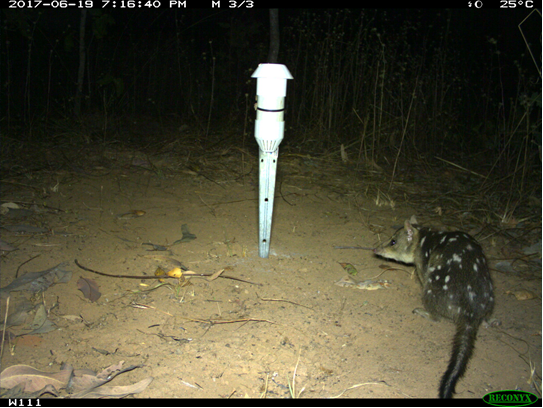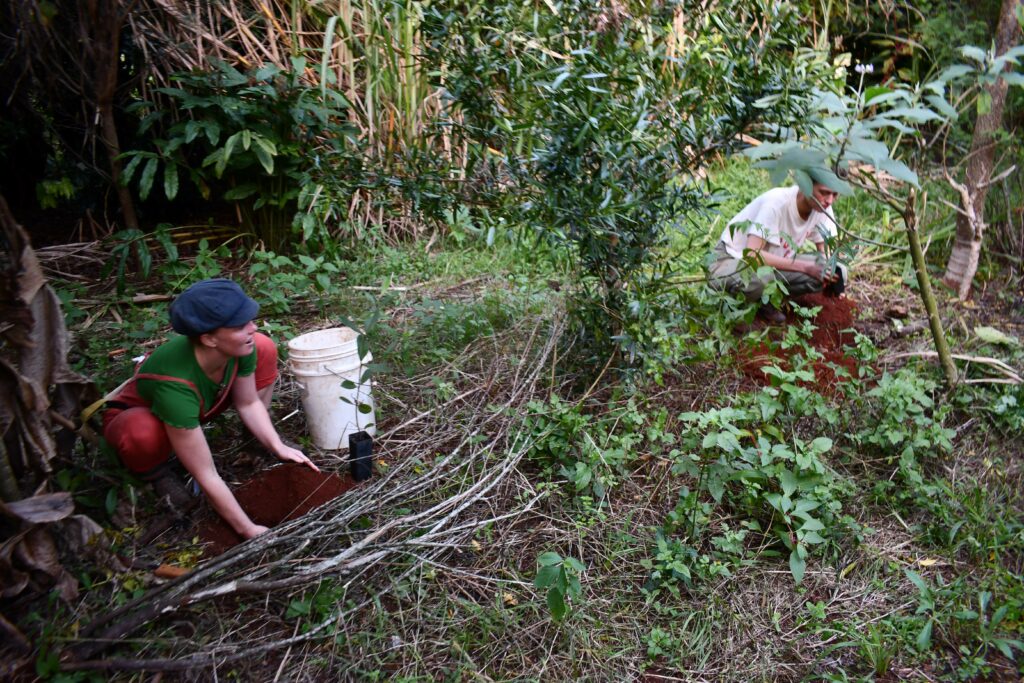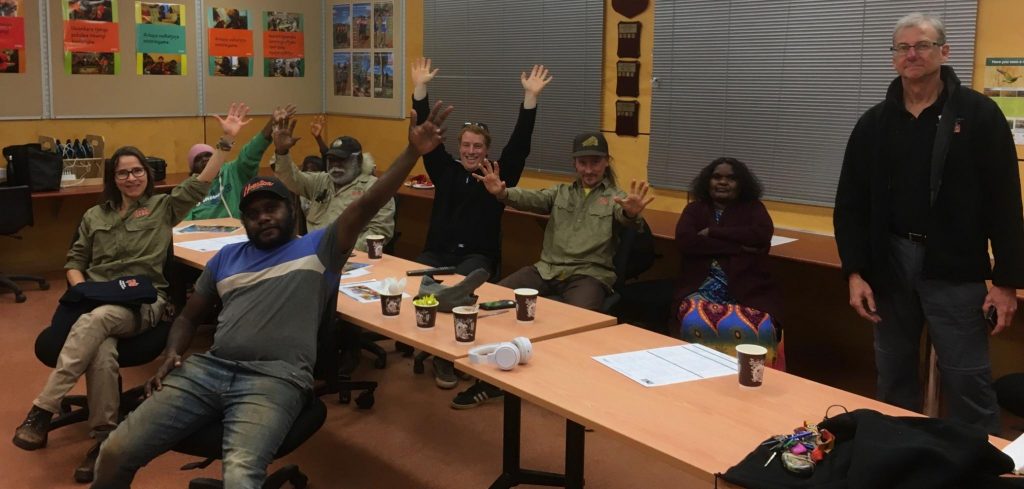Foundation for Rural & Regional Renewal (FRRR)
Youngman Creek rehabilitation volunteer wellbeing program
The Namabunda property, situated in what was once the Big-Scrub subtropical rainforest covering over 75,000 Ha of the Northern Rivers, has degraded over the past 30 years – since its days as a lychee farm due to a lack of maintenance.
Bundjalung Tribal Society (BTS) is primarily a housing organisation providing social housing for the Aboriginal community in and around Lismore in northern NSW. They inherited the property and have spent many years, with volunteer support, trying to rehabilitate it to use for cultural activities and ecological preservation, planting bush tucker and medicines, running training and capacity building programs. Despite their efforts, setbacks like bushfires and the COVID pandemic have hindered progress. Community engagement, vital for sustaining the project, has waned due to volunteer fatigue and lockdown restrictions. BTS see the degradation of the Youngman Creek on the property as symbolic of the broader environmental and social challenges facing the community.
The group sought funding to help mobilise the community and resource them with support and infrastructure, expert training and capacity building to rehabilitate the Creek.
“By rehabilitating the creek, we rehabilitate ourselves and our community.”
With a grant of $9,997, supported by GlobalGiving, the group hosted a series of events at Namabunda which attracted significant community participation, including:

- Build community cohesion through shared activities and cultural workshops.
- Provide training in bush regeneration and ecosystem management for volunteers, especially in photographic monitoring of weed removal and tree planting;
- Offer wellbeing support and workshops led by qualified counselors to address the emotional toll of recent challenges.
- Deliver Bundjalung cultural and ecological knowledge workshops, installing didactic signs about the work to increase awareness and use of Bundjalung ecological knowledge and language, and explaining and demonstrating the value of a healthy waterway ecosystem to neighbouring landowners.
These events will integrate practical activities, such as weeding and planting, with educational sessions on assisted native regeneration techniques. A focus on the Youngman Creek watershed aligns with the project’s theme of “renewal” and underscores the interconnectedness of environmental and community resilience.
Moving forward, Namabunda serves as a model for holistic, community-driven land management that nurtures both people and the environment.
“The thing we are most proud of is the sense of belonging and identity that we have generated through this project in response to the fires, pandemic and then the floods. The thing that was most successful is the deeper engagement between Bundjalung people and non-Indigenous people. The connections that we have built up over the last 18 months is really beautiful to see”.
Ngaanyatjarra Country
Indigenous Rangers play a critical role in protecting the environment and managing country. In most places where they operate, they manage threatened species, manage the land using cool burns and fire and control feral animals – alongside developing tourism and cultural heritage activities.
The Indigenous Desert Alliance (IDA) runs an annual conference to bring together ranger groups from across the remote Southern Deserts to build Indigenous-led networks, leadership confidence and capability, increase skills relevant to Ranger groups and build advocacy for Indigenous land management. These rangers collectively manage an area approximately the size of Victoria.
The Forum is a highly regarded desert event that has been held annually since 2017, and focuses on maximising networking opportunities with an interactive program including workshops, tours, engaging conference sessions and stalls. It’s an important opportunity for Indigenous desert rangers to come together and build their alliance for personal and professional outcomes, to share their successes, challenges and opportunities, and to spend time with valued partners, stakeholders and experts.
Due to travel restrictions, the 2020 Southern Desert Rangers Forum and their Annual Conference were held online. The $25,000 grant IDA received from FRRR’s Strengthening Rural Communities program, funded by the Baxter Charitable Foundation, was originally intended to assist with the transport costs to bring five emergent remote ranger groups to Warakurna for the Forum. Instead, IDA used the funds to set up dedicated studios in Perth to run the events, with full technical support. IDA also purchased video conferencing equipment to enable the remote teams to participate in the events.
Despite meeting over Zoom, there was active participation and over 150 people in attendance over the three days the program ran, including 19 Australian Desert Ranger Groups from across the Southern Deserts, as well as rangers from the Misipawistik Cree Nations in Canada. There were presentations from Birriliburu Rangers, Rangers from APY Lands in SA, and Maralinga Tjarutja Rangers from Oak Valley.
Sessions included practical training components for rangers using GIS mapping software; co-design of education resources for weed eradication in the desert (developed in both Aboriginal language and in English); a presentation from the Threatened Species Commissioner; as well as open discussions around traditional knowledge of burning in the desert and implications for bushfires in populous coastal regions. Importantly, the highly-valued ‘Ranger to Ranger’ sessions still ran, where rangers develop and inform the priorities of the Indigenous Desert Alliance.
Emmanual Hondras, IDA Coordinator, said that there were unexpected outcomes resulting from the online delivery mode, including greater engagement between participants which he attributed to their increased comfort from being able to remain On Country.
“The IDA pivoted to ensure that our members in regional and remote Australia were still connected despite the scourge of COVID-19, providing the chance for leadership confidence and capability to grow through a new means, the opportunity for regional and remote priorities to be discussed and progressed, and the opportunity for these to be advocated to key political and bureaucratic leaders.
“Despite many people thinking it couldn’t be done, we managed to ‘keep the desert connected’ during a pandemic and during travel restrictions. It was a landmark event for Indigenous desert rangers in regional and remote communities.”
Emmanuel Hondras, IDA Coordinator
IDA used the learnings from this event to inform their Annual Conference, which was also run via video conference and attracted over 200 attendees. Thirty-one groups attended the Conference held in November – an astounding result, given that this was the first attempt at full forums / conferences via these means.
The $25,000 grant IDA received from FRRR’s Strengthening Rural Communities program, funded by the Baxter Charitable Foundation, was originally going to be used to assist with the transport costs to bring five emergent remote ranger groups to Warakurna for the forum. Instead, IDA set up dedicated studios in Perth to run the events, with full technical support. This is where the majority of total costs ended up falling, along with venue hire and catering. IDA also purchased video conferencing equipment to enable the remote teams to participate in the events.
IDA has since helped other not-for-profit organisations in the area, using their new-found knowledge and skills to assist with these organisations with their online events, which in itself is a great capacity building outcome.
Warddeken, an Aboriginal owned not-for-profit company, combines traditional ecological knowledge with Western science to manage and protect one of Australia’s most unique environments.

Arnhem Land covers 97,000 sq km of the top end of the Northern Territory.
During the second half of the twentieth century, many Traditional Owners were encouraged to move away from either remote parts of Arnhem Land and join missions, or larger communities to search for more ‘traditional’ work opportunities.
As a result, many parts of the area were left without people and ‘Country was orphaned’ – the term used for land without its people.
Over a number of decades fine-scale fire management was replaced by raging yearly wildfires, feral animals and invasive plants severely impacting the native species.
The plants and animals that make up the local ecosystems had previously evolved to rely on Bininj (the Aboriginal people of Western Arnhem Land), however the disruption in traditional Indigenous land management diminished the ecosystem and led to plummeting numbers of small to medium–weight mammals. This included culturally important species like djabbo / northern quoll and bakkadji / black-footed tree-rat. Refugia, including rainforest patches shrunk and fresh-water places were destroyed.
Getting things back on track
Warddeken is an Aboriginal-owned, not-for-profit company that combines traditional ecological knowledge with Western science to manage and protect one of Australia’s most unique environments.
Warddeken operates out of the remote homeland communities of Kabulwarnamyo, Manmoyi and Mamadawerre in west Arnhem Land. Each year up to 180 Indigenous rangers work on a variety of projects including fire management and carbon abatement, invasive weed and feral animal control, rock art conservation, education and cultural heritage management.
In 2010 Aboriginal Elders from the Warddeken and Djelk IPAs established the Karrkad-Kanjdji Trust to seek philanthropic sources of funding for land management and cultural projects.
Last year, they received a $15,000 Seeds of Renewal grant from ANZ and FRRR to help fund a network of cameras that look into the prevalence of djabbo (northern quoll) on the land to understand the impact of its own land management practices and programs on this priority mammal species.

Curbing the decline
Djabbo populations identified by the monitoring project are actively considered in annual early burning and wildfire suppression activities, and are targeted for further investigation for the purposes of building population resilience.
With meaningful involvement and employment of landowners and rangers, Warddeken will seek to define quoll and major predator feral cat population density and distribution to inform the design of predator suppression strategies if required.
Indigenous rangers, living and working on Country, are best placed to curb the decline in native biodiversity loss and improve habitat for future generations.
Rangers in West and Central Arnhem Land tirelessly blend Indigenous ecological knowledge and western science to control threats and help native species begin to thrive in their natural environment.
CEO of Karrkad Kanjdji Trust, Stacey Irving says “Warddeken’s vision is to have healthy people living and working on healthy country. The generous support of the ANZ Seeds of Renewal program is helping rangers care for species like the Djabbo.’’
Terrah Guymala, Senior Warddeken Ranger adds, “When we, Bininj people, see animals, we get excited because they play a big role in our life through our ceremonies.
“This year we have seen lots of animals that we love, but we hope this number increases so we can physically show our children rather than relying on rock art to tell the stories,” Terrah says.
ANZ General Manager Business Banking Jenefer Stewart says the ANZ Seeds of Renewal program has been providing grants for important initiatives in regional and rural Australia for nearly 20 years.
“Each year I look forward to seeing the difference the grants are able to make in these communities, many of which find it difficult to access the resources they need to grow, develop and prosper,” she says.
Written by Karly Dwyer, ANZ





